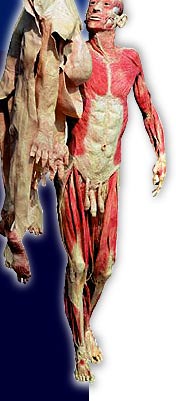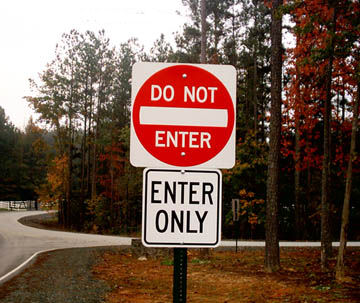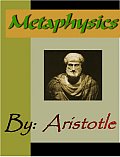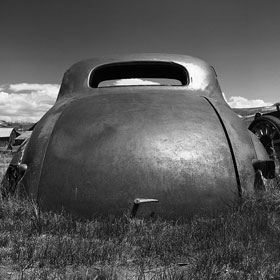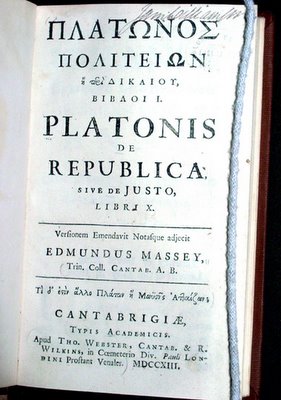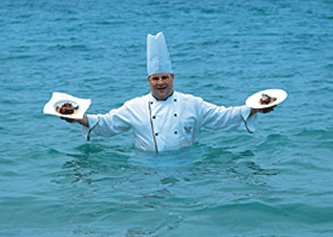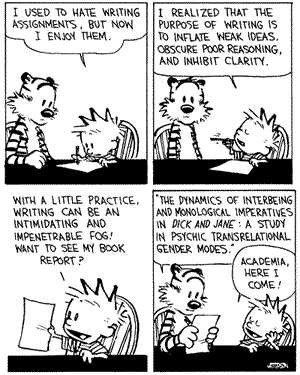 For those of us who are breathing the air of postmodernism, Aristotle's notion of "substance" is proving to be a difficult thing to grasp. We confuse it with "shape," or think of it as a meaphysical "cookie cutter." S. Marc Cohen, in his article, "Aristotle's Metaphysics," for the Stanford Encyclopedia of Philosophy clarifies the notion for us. Read the entire article at
For those of us who are breathing the air of postmodernism, Aristotle's notion of "substance" is proving to be a difficult thing to grasp. We confuse it with "shape," or think of it as a meaphysical "cookie cutter." S. Marc Cohen, in his article, "Aristotle's Metaphysics," for the Stanford Encyclopedia of Philosophy clarifies the notion for us. Read the entire article at
http://plato.stanford.edu/entries/aristotle-metaphysics/#WhaSub 5. What is Substance?
In the seventeen chapters that make up Book Ζ of the Metaphysics, Aristotle takes up the promised study of substance. He begins by reiterating and refining some of what he said in Γ: that ‘being’ is said in many ways, and that the primary sense of ‘being’ is the sense in which substance are beings. Here, however, he explicitly links the secondary senses of ‘being’ to the non-substance categories. The primacy of substance leads Aristotle to say that the age-old question ‘What is being?’ “is just the question ‘What is substance?’” (1028b4).
One might have thought that this question had already been answered in the Categories. There we were given, as examples of primary substances, an individual man or horse, and we learned that a primary substance is “what is neither in a subject nor said of a subject” (2a10). This would seem to provide us with both examples of, and criteria for being, primary substances. But in Metaphysics Ζ, Aristotle does not seem to take either the examples or the criteria for granted.
In Ζ.2 he recounts the various answers that have been given to the question of which things are substances — bodies (including plants, animals, the parts of plants and animals, the elements, the heavenly bodies), things more basic than bodies (surfaces, lines, and points), imperceptible things (such as Platonic Forms and mathematical objects) — and seems to regard them all as viable candidates at this point. He does not seem to doubt that the clearest examples of substances are perceptible ones, but leaves open the question whether there are others as well.
Before answering this question about examples, however, he says that we must first answer the question about criteria: what is it to be a substance (tên ousian prôton ti estin)? The negative criterion (“neither in a subject nor said of a subject”) of the Categories tells us only which things are substances. But even if we know that something is a substance, we must still say what makes it a substance — what the cause is of its being a substance. This is the question to which Aristotle next turns. To answer it is to identify, as Aristotle puts it, the substance of that thing.
6. Substance, Matter, and Subject
Z.3 begins with a list of four possible candidates for being the substance of something: essence, universal, genus, and subject. Presumably, this means that if x is a substance, then the substance of x might be either (i) the essence of x, or (ii) some universal predicated of x, or (iii) a genus that x belongs to, or (iv) a subject of which x is predicated. The first three candidates are taken up in later chapters, and Ζ.3 is devoted to an examination of the fourth candidate: the idea that the substance of something is a subject of which it is predicated.
A subject, Aristotle tells us, is “that of which everything else is predicated, while it is itself not predicated of anything else” (1028b36). This characterization of a subject is reminiscent of the language of the
Categories, which tells us that a primary substance is not predicated of anything else, whereas other things are predicated of it. Candidate (iv) thus seems to reiterate the
Categories criterion for being a substance. But there are two reasons to be wary of drawing this conclusion. First, whereas the subject criterion of the
Categories told us that substances were the ultimate subjects of predication, the subject criterion envisaged here is supposed to tell us what the substance of something is. So what it would tell us is that if x is a substance, then the substance of x — that which makes x a substance — is a subject that x is predicated of. Second, as his next comment makes clear, Aristotle has in mind something other than this
Categories idea. For the subject that he here envisages, he says, is either matter or form or the compound of matter and form. These are concepts from Aristotle's
Physics, and none of them figured in the ontology of the
Categories. To appreciate the issues Aristotle is raising here, we must briefly compare his treatment of the notion of a subject in the
Physics with that in the
Categories.In the
Categories, Aristotle was concerned with subjects of predication: what are the things we talk about, and ascribe properties to? In the
Physics, his concern is with subjects of change: what is it that bears (at different times) contrary predicates and persists through a process of change? But there is an obvious connection between these conceptions of a subject, since a subject of change must have one predicate belonging to it at one time that does not belong to it at another time. Subjects of change, that is, are also subjects of predication. (The converse is not true: numbers are subjects of predication — six is even, seven is prime — but not of change.)
In the
Categories, individual substances (a man, a horse) were treated as fundamental subjects of predication. They were also understood, indirectly, as subjects of change. (“A substance, one and the same in number, can receive contraries. An individual man, for example, being one and the same, becomes now pale and now dark, now hot and now cold, now bad and now good” 4a17-20.) These are changes in which substances move, or alter, or grow. What the
Categories did not explore, however, are changes in which substances are generated or destroyed. But the theory of change Aristotle develops in the
Physics requires some other subject for changes such as these — a subject of which substance is predicated — and it identifies matter as the fundamental subject of change (192a31-32). Change is seen in the
Physics as a process in which matter either takes on or loses form.
The concepts of matter and form, as we noted, are absent from the
Categories. Individual substances — this man or that horse — apart from their accidental characteristics — the qualities, etc., that inhere in them — are viewed in that work as essentially simple, unanalyzable atoms. Although there is metaphysical structure to the fact that, e.g., this horse is white (a certain quality inheres in a certain substance), the fact that this is a horse is a kind of brute fact, devoid of metaphysical structure. This horse is a primary substance, and horse, the species to which it belongs, is a secondary substance. But there is no predicative complex corresponding to the fact that this is a horse in the way that there is such a complex corresponding to the fact that this horse is white.
But from the point of view of the
Physics, substantial individuals are seen as predicative complexes (cf. Matthen 1987); they are hylomorphic compounds — compounds of matter and form — and the subject criterion looks rather different from the hylomorphic perspective.
Metaphysics Ζ.3 examines the subject criterion from this perspective.
Matter, form, and the compound of matter and form may all be considered subjects, Aristotle tells us, (1029a2-4), but which of them is substance? The subject criterion by itself leads to the answer that the substance of x is an entirely indeterminate matter of which x is composed (1029a10). For form is predicated of matter as subject, and one can always analyze a hylomorphic compound into its predicates and the subject of which they are predicated. And when all predicates have been removed (in thought), the subject that remains is nothing at all in its own right — an entity all of whose properties are accidental to it (1029a12-27). The resulting subject is matter from which all form has been expunged. (Traditional scholarship calls this “prime matter,” but Aristotle does not here indicate whether he thinks there actually is such a thing.) So the subject criterion leads to the answer that the substance of x is the formless matter of which it is ultimately composed.
But Aristotle rejects this answer as impossible (1029a28), claiming that substance must be “separate” (
chôriston) and “some this” (
tode ti, sometimes translated “this something”), and implying that matter fails to meet this requirement. Precisely what the requirement amounts to is a matter of considerable scholarly debate, however. A plausible interpretation runs as follows. Being separate has to do with being able to exist independently (x is separate from y if x is capable of existing independently of y), and being some this means being a determinate individual. So a substance must be a determinate individual that is capable of existing on its own. (One might even hold, although this is controversial, that on Aristotle's account not every “this” is also “separate.” A particular color or shape might be considered a determinate individual that is not capable of existing on its own — it is always the color of shape of some substance or other.) But matter fails to be simultaneously both
chôriston and
tode ti. The matter of which a substance is composed may exist independently of that substance (think of the wood of which a desk is composed, which existed before the desk was made and may survive the disassembly of the desk), but it is not as such any definite individual — it is just a quantity of a certain kind of matter. Of course, the matter may be construed as constituting a definite individual substance (the wood just is, one might say, the particular desk it composes), but it is in that sense not separate from the form or shape that makes it that substance (the wood cannot be that particular desk unless it is a desk). So although matter is in a sense separate and in a sense some this, it cannot be both separate and some this. It thus does not qualify as the substance of the thing whose matter it is.
7. Substance and Essence
Aristotle turns in Ζ.4 to a consideration of the next candidate for substance: essence. (‘Essence’ is the standard English translation of Aristotle's curious phrase to ti ên einai, literally “the what it was to be” for a thing. This phrase so boggled his Roman translators that they coined the word essentia to render the entire phrase, and it is from this Latin word that ours derives. Aristotle also sometimes uses the shorter phrase
to ti esti, literally “the what it is,” for approximately the same idea.) In his
logical works, Aristotle links the notion of essence to that of definition (horismos) — “a definition is an account (logos) that signifies an essence” (Topics 102a3) — and he links both of these notions to a certain kind of per se predication (kath’ hauto, literally, “in respect of itself”) — “what belongs to a thing in respect of itself belongs to it in its essence (en tôi ti esti)” for we refer to it “in the account that states the essence” (Posterior Analytics, 73a34-5). He reiterates these ideas in Ζ.4: “there is an essence of just those things whose logos is a definition” (1030a6), “the essence of a thing is what it is said to be in respect of itself” (1029b14). It is important to remember that for Aristotle, one defines things, not words. The definition of tiger does not tell us the meaning of the word ‘tiger’; it tells us what it is to be a tiger, what a tiger is said to be in respect of itself. Thus, the definition of tiger states the essence — the “what it is to be” of a tiger, what is predicated of the tiger per se.
Aristotle's preliminary answer (Z.4) to the question “What is substance?” is that substance is essence, but there are important qualifications. For, as he points out, “definition (horismos), like ‘what it is’ (ti esti), is said in many ways” (1030a19). That is, items in all the categories are definable, so items in all the categories have essences — just as there is an essence of man, there is also an essence of white and an essence of musical. But, because of the pros hen equivocity of ‘is’, such essences are secondary — “definition and essence are primarily (protôs) and without qualification (haplôs) of substances” (1030b4-6). Thus, Ζ.4 tells us, it is only these primary essences that are substances. Aristotle does not here work out the details of this “hierarchy of essences” (Loux, 1991), but it is possible to reconstruct a theory of such a hierarchy on the basis of subsequent developments in Book Ζ.
In Ζ.6, Aristotle goes on to argue that if something is “primary” and “spoken of in respect of itself (kath’ hauto legomenon)” it is one and the same as its essence. The precise meaning of this claim, as well as the nature and validity of the arguments offered in support of it, are matters of scholarly controversy. But it does seem safe to say that Aristotle thinks that an “accidental unity” such as a pale man is not a kath’ hauto legomenon (since pallor is an accidental characteristic of a man) and so is not the same as its essence. Pale man, that is to say, does not specify the “what it is” of any primary being, and so cannot be an essence of the primary kind. As Ζ.4 has already told us, “only species of a genus have an essence” (1030a11-12) in the primary sense. Man is a species, and so there is an essence of man; but pale man is not a species and so, even if there is such a thing as the essence of pale man, it is not, at any rate, a primary essence.
At this point there appears to be a close connection between the essence of a substance and its species (eidos), and this might tempt one to suppose that Aristotle is identifying the substance of a thing (since the substance of a thing is its essence) with its species. (A consequence of this idea would be that Aristotle is radically altering his conception of the importance of the species, which in the Categories he called a secondary substance, that is, a substance only in a secondary sense.) But such an identification would be a mistake, for two reasons. First, Aristotle's point at 1030a11 is not that a species is an essence, but that an essence of the primary kind corresponds to a species (e.g., man) and not to some more narrowly delineated kind (e.g., pale man). Second, the word ‘eidos’, which meant ‘species’ in the logical works, has acquired a new meaning in a hylomorphic context, where it means ‘form’ (contrasted with ‘matter’) rather than ‘species’ (contrasted with ‘genus’). In the conceptual framework of Metaphysics Ζ, a universal such as man or horse — which was called a species and a secondary substance in the Categories — is construed as “not a substance, but a compound of a certain formula and a certain matter, taken universally” (Z.10, 1035b29-30). The eidos that is primary substance in Book Ζ is not the species that an individual substance belongs to but the form that is predicated of the matter of which it is composed (Cf. Driscoll 1981).
8. Substances as Hylomorphic Compounds
The role of form in this hylomorphic context is the topic of Ζ.7-9. (Although these chapters were almost certainly not originally included in Book Ζ — there is no reference to them, for example, in the summary of Ζ given in Η.1, which skips directly from Ζ.6 to Ζ.10 — they provide a link between substance and form and thus fill what would otherwise be a gap in the argument.) Since individual substances are seen as hylomorphic compounds, the role of matter and form in their generation must be accounted for. Whether we are thinking of natural objects, such as plants and animals, or artifacts, such as houses, the requirements for generation are the same. We do not produce the matter (to suppose that we do leads to an infinite regress) nor do we produce the form (what could we make it out of?); rather, we put the form into the matter, and produce the compound (Z.8, 1033a30-b9). Both the matter and the form must pre-exist (Z.9, 1034b12). But the source of motion in both cases — what Aristotle calls the “moving cause” of the coming to be — is the form.
In artistic production, the form is found in the soul of the artisan, for “the art of building is the form of the house” (1034a24) and “the form is in the soul” (1032b23) of the artisan. For example, the builder has in mind the plan or design for a house and he knows how to build; he then “enmatters” that plan or design by putting it into the materials out of which he builds the house. In natural production, the form is found in the parent, where “the begetter is the same in kind as the begotten, not one in number but one in form — for man begets man” (1033b30-2). But in either case, the form pre-exists and is not produced (1033b18).
As for what is produced in such hylomorphic productions, it is correctly described by the name of its form, not by that of its matter. What is produced is a house or a man, not bricks or flesh. Of course, what is made of gold may still be described in terms of its material components, but we should call it not “gold” but “golden” (1033a7). For if gold is the matter out of which a statue is made, there was gold present at the start, and so it was not gold that came into being. It was a statue that came into being, and although the statue is golden — i.e., made of gold — it cannot be identified with the gold of which it was made.
The essence of such a hylomorphic compound is evidently its form, not its matter. As Aristotle says “by form I mean the essence of each thing, and its primary substance” (1032b1), and “when I speak of substance without matter I mean the essence” (1032b14). It is the form of a substance that makes it the kind of thing that it is, and hence it is form that satisfies the condition initially required for being the substance of something. The substance of a thing is its form.
